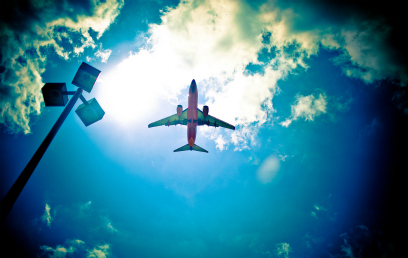Gremlin On the Wing
How do you define the fear of flying? Scientists think it might be the sum of other fears.
We’d wager that not too many A&S readers suffer from a fear of flying (or maybe you’re just masochists). But given that experts estimate between 10 and 40 percent of the adult population does, you probably know someone who gets the sweaty palms once they’re racing down the runway — or just refuses to book a ticket in the first place.
There are all sorts of reasons people are afraid to fly, and given the complexities of the human noggin, they’re as difficult to pin down as they are different for each person. A new study, however, tries to define why this phobia is so difficult to define.
In the October 2011 issue of Aviation, Space and Environmental Medicine, Janice Hawkins-Gilligan, Judith A. Dygdon, and Anthony J. Conger present “Examining the Nature of Fear of Flying.” They begin with previous research suggesting that this particular fear doesn’t stem so much from causal events — having a scary flight experience or even fear of having a scary experience — but from a combination of other fears that all get trapped together in a big metal tube. Those may include a fear of heights, water, enclosed places, or social situations, all of which can be part of the flying experience.
Gilligan, Dygdon and Conger gave 109 subjects detailed questionnaires regarding their flying experience, level of fear (if any), and the existence and level of other fears. They hoped to compare 1) fear of flying as a manifestation of the dangers of flying itself and 2) fear of flying as a manifestation of other fears during flight — called “flight-embedded fears.”
Indeed, they found that:
In this study, appears to be comprised of flight-embedded fears to a much greater degree than it is caused by flight-specific conditioning experiences. Though some subjects reported bad experiences with flying, those experiences did not override the predictive power of flight-embedded fears.
What’s particularly interesting about this finding is that many folks who develop a fear of flying from other fears — say agoraphobia or falling — have usually learned to overcome those individual fears in their everyday lives because they’re only forced to deal with them one at a time (that is, they only need to leave the house; not leave the house while jumping off a pier). “When flying, however, all of these stimuli are presented together and in a context which allows no easy means of escape,” the authors note.
One way to reduce the fear, they suggest, is to make flying more of a habit — not just flying more often (obviously not a possibility for everyone), but making the process itself something reliably knowable.
The more the process of flying is routine, the less likely surprising events and resultant dishabituation will occur. Commercial air travel already contains a certain degree of predictable “ceremony” and this likely minimizes the re-emergence of .
So…hang on a minute. Does that mean that the ever increasing rigmarole we go through to get on a plane these days might be making it easier for some people to actually get on the plane? Maybe I could carry on my full bottle of shampoo if I just promise to hold your hand?
